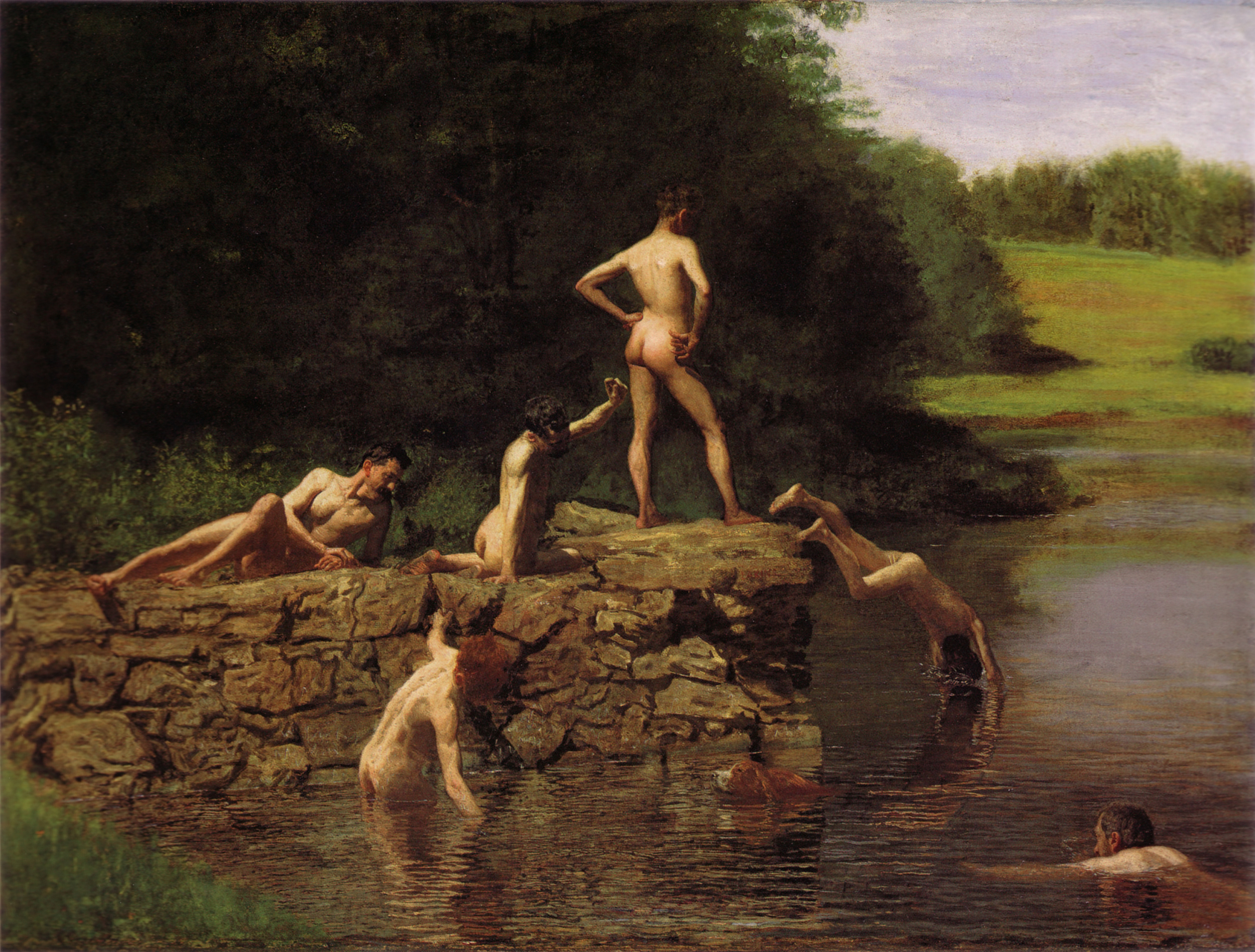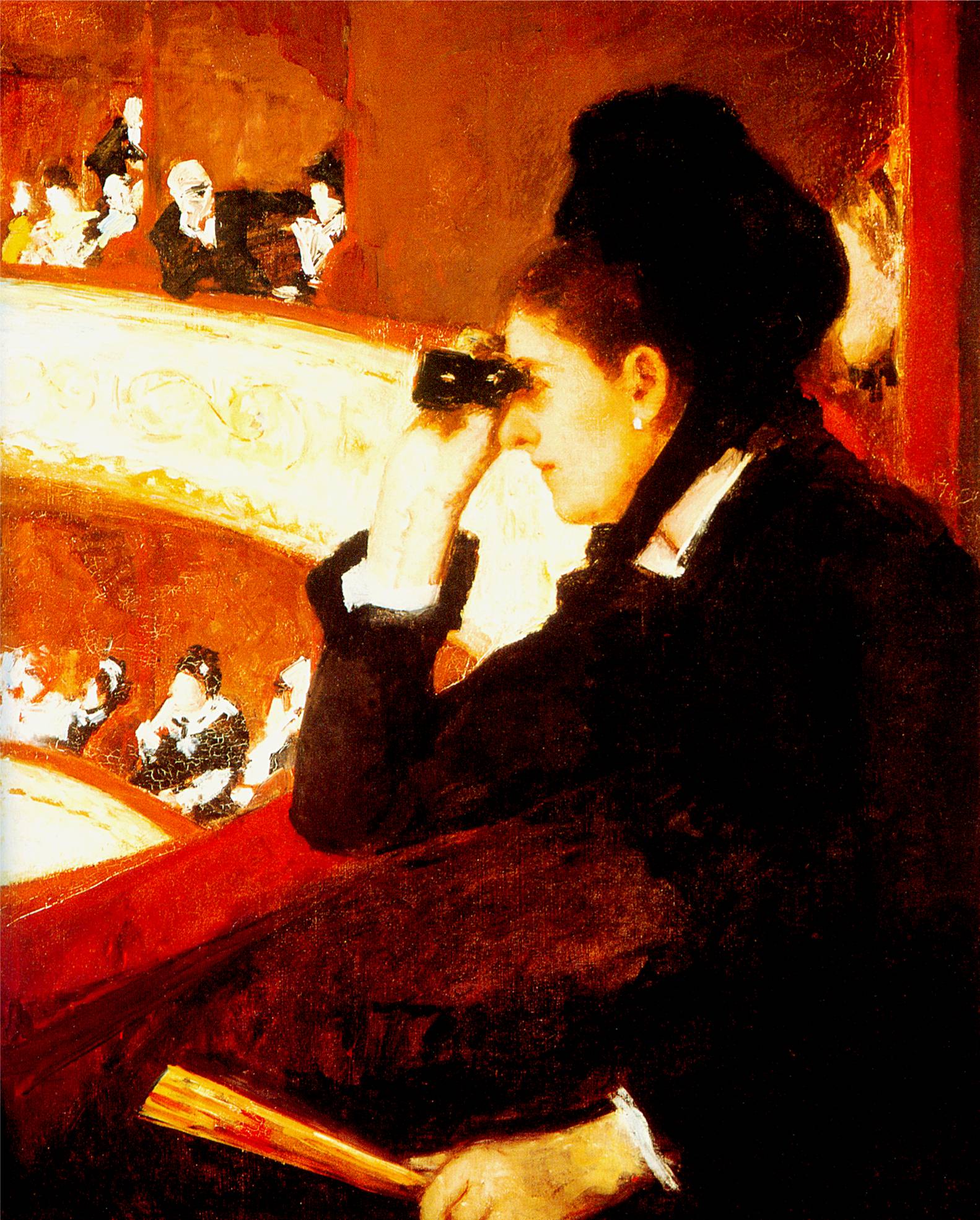Two artists who exemplified many of the tensions and technical innovations of the the late 19th century were Mary Cassatt and Thomas Eakins. Both painters were born in the United States, both traveled abroad and spent a significant amount of time in Europe (Cassatt living most of her life in France), and the rendering of the human figure through innovative portraits is a main focus in their oeuvres. Despite all these similarities, the pictorial language and technique of these two artists could not be more different. Whereas Eakins belonged to the Realist movement, Cassatt belonged to the Impressionist movement that emerged in the 1860's.
The Impressionist movement did not result from an immediate shift in ideas and techniques used by artists of the time. The seeds that propelled the movement can be found in the individualist Romanticism of Delacroix as well as the avant-garde ideas proposed by Courvet's oeuvre. The individual freedom that artists like Delacroix were always after acquired a new importance for Impressionist painters who, after the enlightenment, the French Revolution, and the advent of Photography, found themselves in an adequate social and political environment to realize themselves as free artists. Choosing not to be bound by the rules and procedures of the French Academy, Impressionist painters would set in motion with their innovations the Modern Age of painting.
 |
Mary Cassatt Young Women Picking
Fruit, 1892 |
Holding individualism as the highest principle to follow, Impressionist painters were avant-garde innovators and Mary Cassatt was no exception. Her work exemplifies the general characteristics that came to define impressionist oeuvres. In her painting Young Women Picking Fruit, 1892 the departure from previous art forms is evident. In the painting, the previously imperative use of chiaroscuro is missing. In fact, the flatness of the painting serves to make the paint itself, the colors used, and the subject even more salient. Impressionist works came to also be known for the distinct tâches of paint that shifted the focus from a painting's narrative to the paint itself. In Young Women Picking Fruit, the viewer easily sees every brushstroke Cassatt painted. The importance of capturing light at a specific moment, in the case of this painting the way light shines as two women are in a garden and one of them picks the fruits from a tree, is also notable in Impressionist art. The lilac undertones in the female's white dress suggest this effect of light on the subject.
The capturing of the way light transforms a certain subject shifts the previous focus on two dimensional representations of a three dimensional world, to the capturing of an optical effect at an specific moment in time. In this way, the individualist character of impressionist art ties in with its technical aspects. The premier impressionist artist strived to give his/her own "impression" or optical vision of a subject, and in doing so, attempted to capture the fleeting moment, a moment affected by the way light shines.
 |
Thomas Eakins Portrait of Benjamin
Howard Professor Rand, 1874 |
In contrast to Cassat, Eakins's work differs in technique and subject. Eakins attempted to capture the true essence of American life and in capturing a "true portrayal" he gives a realist rendition of his surroundings. In his portraits and landscapes we see a painter that like Cassatt, did not want to conform to the conventions of the time, and who chose to portray the individual character of all his subjects. Eakins in his portraits rejects the notion that a portrait must be flattering to be successful. His work is also notorious for his representations of the "American Hero". In paintings like
Portrait of Benjamin Howard Professor Rand, 1874, Eakins tries to represent with the outmost reality the fact that the new modern hero is the professional American male who through his work is changing the destiny of his country. In this case the subject is a physician whose intellectual concentration is his most salient feature. He is clearly defined by his intellectual and professional achievements. Like Eakins, Cassatt sought to render the "modern hero" but in her case, the modern hero happened to be female. Therein lies the biggest difference between these two contemporaries. They both had different visions in regards to gender roles and gender identity.
Mary Cassatt sought to portray the world of women as women themselves defined it. In her paintings Cassatt portrays her world as defined by herself and the relationships she has with other women and with children. This is the world of the upper class, of cultivated people, but also a world where women are individuals complete within themselves. Women in her oeuvre are free entities who go to the opera by themselves as seen in Woman in Black at the Opera, 1880 and who lead lives not preoccupying themselves with the constant male gaze. They ride carriages, and enjoy the company of other women as seen in Young Women Picking Fruit. Cassatt is one of the first painters who portrays the close relationships that women had with other women and did so in a very natural way. Cassatt's subjects were also primarily female and powerful in their own right. Her work differs greatly with Eakins's in this regard as he primarily represented women as a contrary and supplementary force to men. This is clearly seen in his painting The Gross Clinic, 1875 in which the woman who sits at the left is a striking opposite to the main focus of the painting, the male surgeon. She is portrayed as a frail figure, scared, and unable to look at the scene before her while the males are portrayed as unsentimental and academically focused individuals.
 |
| Thomas Eaknis The Gross Clinic, 1875 |
Cassatt's modern vision for women and the role that in her view women should hold in society is best allegorized in the mural she painted for the Chicago 1893 World's Columbian Exposition. In
Modern Women she portrays women picking the fruits of science and knowledge and women pursuing fame. Both of this representations challenge the passive role women were supposed to have in society. These representations also exemplify the great differences that lie in Eakins and Cassatt's work and in the society of their time. As Impressionism brought about the modern age of painting, one is able to see in Cassatt's oeuvre an example of a modern work but also an example of a modern vision for the women of her time. Eakins's work in contrast focuses on the roles men play in society and his realist style embeds his subjects with all the idiosyncrasies that ushered the modern age.
For more on Mary Cassatt, a documentary is available
here.
References
Fillin Yeh, Susan. Mary Cassatt's Images of Women. Art Journal. Vol. 35, No. 4 (Summer, 1976).
Eisenman, Stephen F. Nineteenth Century Art: A Critical History. 4th Edition. New York, NY: Thames &Hudson, 2011.

 In comparison, Thomas Eakins, a fellow American Realist painter, painted homage after homage to men of different ages and class—yet the common denominator was the unquestionable power of these men. In 1885, Eakins presented The Swimming Hole. The horizontal oil painting depicts a group of young men enjoying the cool waters of the lake on a warm day. The pyramidal composition consists of dark shadows of the trees and lake water; all punctuated by the pale bodies of the young men. Eakins introduces a few concepts: man’s conquest of nature, hegemonic masculinity, and homoeroticism. The man located at the edge of the rocks stands tall with his hands planted by his hips. Although he is unaware of the spectator, he exudes dominance as he looks onto the water and trees. To his right, a man dives into the water and Eakins chose to capture the moment he breaks the water: nature cannot keep man out of its bounty. The absence of women in this painting speaks volumes—women do not have the freedom nor the virtue of achieving or innovating America's future. The Swimming Hole clearly translates the Platonic philosophy that higher thinking and immortal triumphs solely belong to men.
In comparison, Thomas Eakins, a fellow American Realist painter, painted homage after homage to men of different ages and class—yet the common denominator was the unquestionable power of these men. In 1885, Eakins presented The Swimming Hole. The horizontal oil painting depicts a group of young men enjoying the cool waters of the lake on a warm day. The pyramidal composition consists of dark shadows of the trees and lake water; all punctuated by the pale bodies of the young men. Eakins introduces a few concepts: man’s conquest of nature, hegemonic masculinity, and homoeroticism. The man located at the edge of the rocks stands tall with his hands planted by his hips. Although he is unaware of the spectator, he exudes dominance as he looks onto the water and trees. To his right, a man dives into the water and Eakins chose to capture the moment he breaks the water: nature cannot keep man out of its bounty. The absence of women in this painting speaks volumes—women do not have the freedom nor the virtue of achieving or innovating America's future. The Swimming Hole clearly translates the Platonic philosophy that higher thinking and immortal triumphs solely belong to men.












